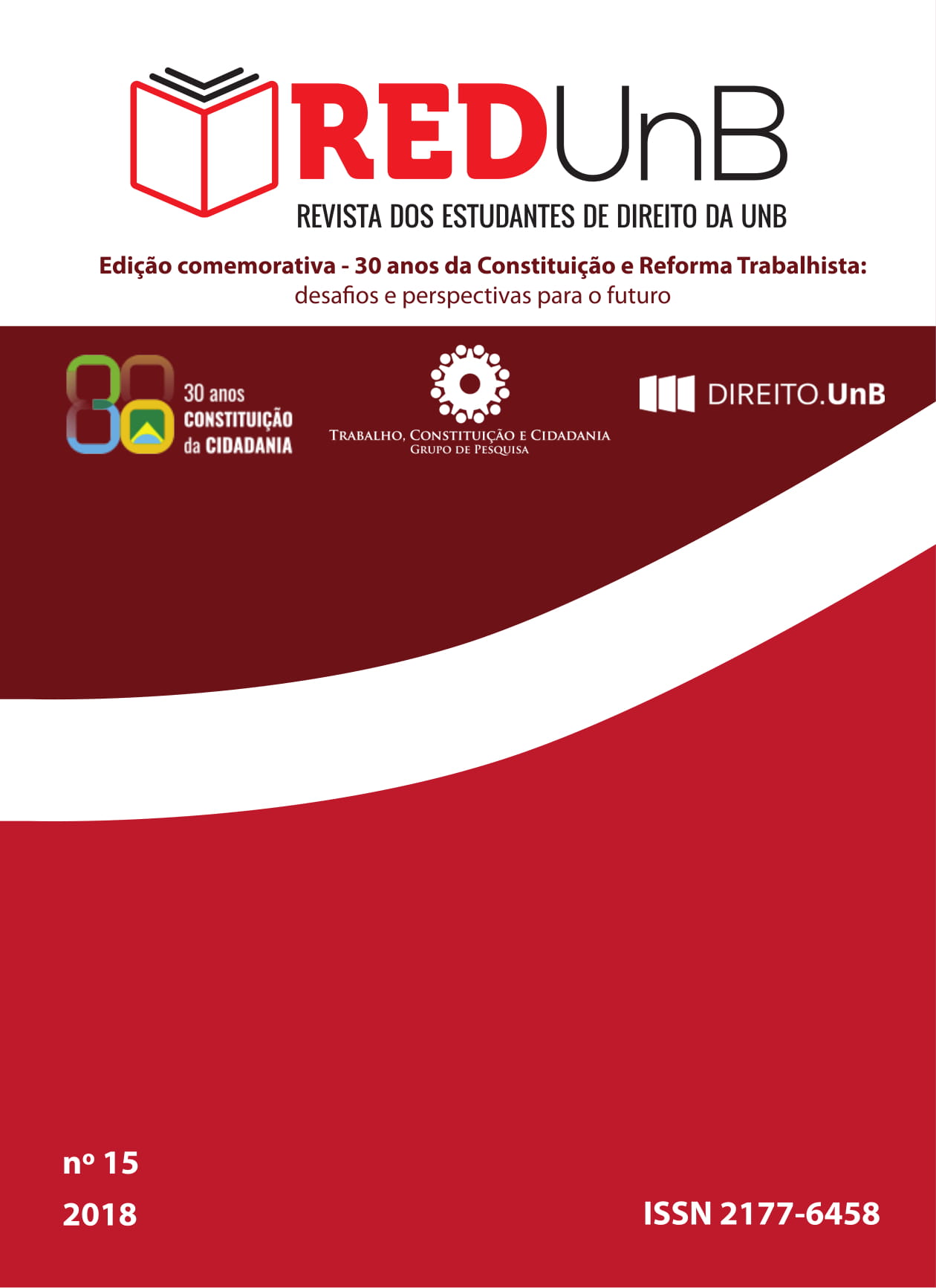HEALTH PROTECTION OF PREGNANT AND LACTATING WORKERS: AN ANALYSIS OF ARTICLE 394-A OF CONSOLIDATION OF LABOR LAWS IN LIGHT OF FEDERAL CONSTITUTION OF 1988 AND INTERNATIONAL GUIDELINES OF HUMAN LABOR PROTECTION
Keywords:
Fundamental right to health, Occupational environment of women, Pregnant, Lactating, Unhealthy work, Article 394-A of Consolidation of Labor LawAbstract
The objective of this study is to comprehend the meaning of article 394-A of the Consolidation of Labor Laws, in its wording given by Law n. 13.467/2017, from a systematic analysis of the constitutional and international normative framework of women’s occupational health protection. To reach that goal, a documental research was made surrounding the rules about pregnant or lactating women’s labor at unhealthy environments, as well as surrounding the justification used to base legislative amendments concerning the subject matter. Subsequently, a bibliographical review followed regarding the fundamental right to health at work environment, as well as the potential damages to pregnant and lactating workers due to exposition to unhealthy agents, anchored in health science researches, specifically concerning noises and chemical agents. Furthermore, the expression “trustworthy doctor” was problematized, foreseen by the current wording of article 394-A of the Consolidation of Labor Laws, as well as the possibility of negotiating the framework of the degree of unhealthiness, in opposition to the rules and guidelines that back up the imperativeness of a technical analysis of themes relative to occupational health. From this study, it was concluded that the alteration introduced to the legal order by means of the new article 394-A of the Consolidation of Labor Laws is another symptom of what the labor reform brings: the crippleness of workers in comparison to the economic power due to legal relaxation, the prevalence of negotiated in detriment of legislated, and the transference of responsibility over women’s occupational health to the worker herself, in affront to the guidelines of Federal Constitution of 1988.
Downloads
References
AGOPIAN, A.J.; DESROSIERS, Tania A.; DUWE, Kara N.; FINNELL, Richard H.; KHODR, Zeina G.; LANGLOIS, Peter H.; LAWSON, Christina C.; LUPO, Philip J.; MITCHELL, Laura E.; MOORE, Cynthia A.; REEFHUIS, Jennita; ROMITTI, Paul A.; SHAW, Gary M.;SYMANSKI, Elaine; WATERS, Martha A. Maternal Occupational Exposure to Polycyclic Aromatic Hydrocarbons: Effects on Gastroschisis among Offspring in he National Birth Defects Prevention Study.Disponível em: https://ehp.niehs.nih.gov/doi/10.1289/ehp.1104305. Acesso em 28/11/2018.
ALBIN, Maria; GUSTAVSSON, Per; LEWNÉ, Marie; ROSENHALL, Ulf; RYLANDER, Lars; SELANDER, Jenny. Maternal Occupational Exposure to Noise during Pregnancy and Hearing Dysfunction in Children: A Nationwide Prospective Cohort Study in Sweden.Disponível em: https://ehp.niehs.nih.gov/doi/10.1289/ehp.1509874. Acesso em 28/11/2018.
ANDREUASAITYTE, Sandra; GRAZULEVICIENE, Regina. Maternal Occupational Exposure and Breastfeeding Impact on Programming Child Allergy. Disponível em: https://ehp.niehs.nih.gov/doi/10.1289/isee.2016.3123. Acesso em 28/11/2018.
ANTUNES, Ricardo. O privilégio da servidão. São Paulo: Boitempo, 2018._________, Ricardo. Os sentidos do trabalho: ensaio sobre a afirmação e a negação do trabalho. São Paulo: Boitempo, 2009.
BRICEÑO, Freddy; MONGE, Patricia; PARTANEN, Timo. Childhood Leukemia and Maternal Occupational Exposures to Organic Solvents in Costa Rica. Disponível em: https://ehp.niehs.nih.gov/doi/10.1289/isee.2011.01509. Acesso em 28/11/2018.
BRITO, Maurício Ferreira. O trabalho da lactante em ambiente insalubre: retrocesso social.2018. Disponível em:https://www.jota.info/opiniao-e-analise/colunas/reforma-trabalhista/o-trabalho-da-lactante-em-ambiente-insalubre-retrocesso-social-11102018/ampAcesso em 10/11/2018.
CARVALHO NETO, Menelick. ‘A Constituição é uma comunidade de princípios’, afirma Menelick de Carvalho. 2018. Disponível em:https://ufmg.br/comunicacao/noticias/constituicao-e-comunidade-de-principios-afirma-menelick-de-carvalho.Acesso em 15/11/2018.
CDSS (2010). Redução das desigualdades no período de uma geração: igualdade na saúde através da acção sobre os seus determinantes sociais. Relatório Final da Comissão para os Determinantes Sociais da Saúde. Portugal, Organização Mundial da Saúde. Disponível em: http://apps.who.int/iris/bitstream/handle/10665/43943/9789248563706_por_contents.pdf;jsessionid=23FAEB9C573E822F5B07B01D979BBB25?sequence=8. Acesso em 28/11/2018.
Constituição (1988). Constituição da República Federativa do Brasil. Brasília, DF: Senado Federal: Centro Gráfico, 1988. 292 p. BRASIL
Constituição da Organização Internacional do Trabalho (OIT) e seu Anexo (Declaração de Filadélfia). Conferência Internacional do Trabalho em Montreal, 1946. Disponível em: https://www.ilo.org/wcmsp5/groups/public/---americas/---ro-lima/---ilo
brasilia/documents/genericdocument/wcms_336957.pdf. Acesso em 15/11/2018.Convenção relativa ao amparo à maternidade. Disponível em: http://www.trtsp.jus.br/geral/tribunal2/LEGIS/CLT/OIT/OIT_103.html#103. Acesso em 28/11/2018.
COSTA, Eder Dion de Paula; STOLZ, Sheila. O direito humano à saúde, segurança e ao meio ambiente do trabalho equilibrado: uma questão de justiça social na perspectiva das organizações intergovernamentais internacionais. In: Direito e saúde: construindo a justiça social.
JÚNIOR, Marco Aurélio Serau; BRAUNER, Maria Cláudia; COSTA, José Ricardo Caetano (Org.). São Paulo: LTr, 2016, p. 15-26.
Declaração Universal Dos Direitos Humanos. Assembleia Geral das Nações Unidas em Paris. 10 dez. 1948. Disponível em: https://www.ohchr.org/EN/UDHR/Pages/Language.aspx?LangID=por. Acesso em 15/11/2018.
DELGADO, Mauricio Godinho. DELGADO. Gabriela Neves. A reforma trabalhista no Brasil: com os comentários à Lei n.º 13.467/2017. São Paulo: LTr, 2017
OLIVEIRA, Sebastião Geraldo de. Proteção jurídica àsaúde do trabalhador. 5a ed. São Paulo: LTr, 2010, p. 70.Parecer ao Projeto de Lei nº 6.787, de 2016. Disponível em: https://www.camara.gov.br/proposicoesWeb/prop_mostrarintegra?codteor=1544961. Acesso em 28/11/2018.
SAFIOTI, Heleieth I.B. A mulher na sociedade de classe. 3.ed-São Paulo: Expressão Popular, 2013.
SILVA, Homero Batista Mateus da. Curso de direito do trabalho aplicado: saúde e segurança do trabalho. 3ª ed. São Paulo: Revista dos Tribunais, 2017
SOUZA, Jessé. A elite do atraso: da escravidão à Lava Jato. Rio de Janeiro: Leya,2017.
TRINDADE, Rodrigo. Nove Meses Depois:o que a Reforma Trabalhista entregou ao mercado de trabalho brasileiro. 2018. Disponível em:http://www.amatra13.org.br/artigos/nove-meses-depois-o-que-a-reforma-trabalhista-entregou-ao-mercado-de-trabalho-brasileiro/.Acesso em10/11/2018.
World health statistics2018: monitoring health for the SDGs, sustainable development goals. Geneva: World Health Organization; 2018. Disponível em: http://apps.who.int/iris/bitstream/handle/10665/272596/9789241565585-eng.pdf?ua=1&ua=1. Acesso em 28/11/2018.


